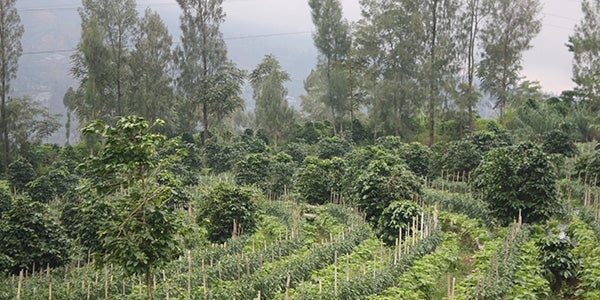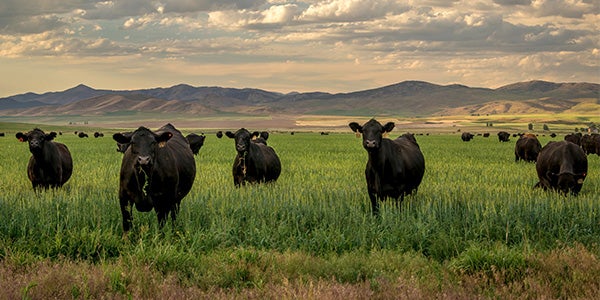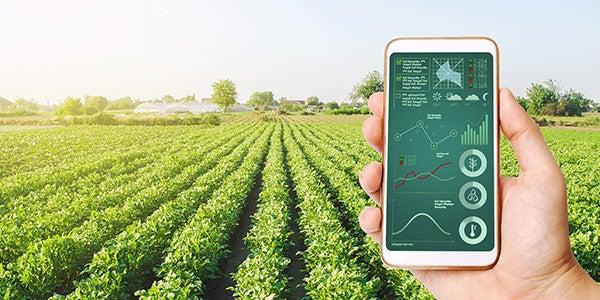Sustainability in agriculture ensures that existing demand is met without jeopardizing future plans. Adopting sustainable practices can improve the communities surrounding large-scale AgriBusiness operations—while supporting the business itself. However, implementing these changes can also prove challenging. Read more in our latest article.
Every business, corporation, and company can leverage the benefits of sustainability to decrease their environmental impact while supporting their bottom line. AgriBusiness is no different. Sustainability in agriculture ensures that existing demand is met without jeopardizing future plans. The concept embodies several ideas, theories, and strategies—there’s no one-size-fits-all solution. Let’s explore the four primary benefits of sustainability in AgriBusiness and what they mean for farms and surrounding communities.
Sustainable Agriculture: The Present and the Future

A growing population demands more food. But pair that increased demand with climate change-fueled harvest constraints, and we’re looking at a 3% compound annual rate increase between now and 2030 for the agriculture input market. Scientists predict the next decade will see a dramatic shift in demand for food worldwide, putting ever more pressure on AgriBusiness to produce. We’ll begin to see the benefits of sustainability on full display as growing need forces upticks in production.
Between 2000 and 2030, the global middle class will have almost quintupled, encompassing five billion people. Those five billion people have begun developing (and will continue embracing) their own new and nuanced consumption habits. Living conditions have improved, so these people have fundamentally shifted their priorities towards nutrition and sustainability. AgriBusiness leaders must ensure they produce enough food while maintaining sustainable business practices to optimize natural resources.
In Trust in Food’s The State of Sustainable Ag report, researchers found that 59% of AgriBusiness leaders had never calculated the economic benefits of adopting sustainable AgriBusiness practices. The report also found that 88% of growers were not involved with a private firm's supply chain sustainability strategy.
These figures mark an opportunity to leverage the middle majority of growers by explaining the potential impacts of sustainability in a way that is directly relevant to their business. It’s imperative to meet producers where they are and give them what they need.
There are significant barriers standing in the way, however. For example, 60% of respondents indicated economic and agronomic ROI proved the most significant roadblocks preventing them from adopting new conservation practices. AgriBusiness leaders also cited lack of time, knowledge, and labor as hindrances to more sustainable practices. Finally, adopting changes requires up-front capital: something 77% of business leaders emphasize as a barrier.
Currently, the only real way to combat financial hurdles for farmers across the United States is the Rural Energy for America Program (REAP), which helps AgriBusinesses adopt clean energy solutions.
Many farmers have called on Congress to fund REAP, which has helped more than 20,000 farmers adopt sustainable energy practices while lowering their energy bills. Lloyd Ritter, director for the Agriculture Energy Coalition, cited REAP as the “most popular and successful energy programs USDA or the federal government has to offer.”
USDA has no further alternatives to REAP, with other related grants focusing on other sectors around the agriculture sector. The only other options for farmers to fund sustainable practices include availing private investments and specialized grants like the Sustainable Agriculture Research and Education (SARE), but many of these have requirements that the average farmer may not qualify for. The National Sustainable Agriculture Coalition provides a list of such grants and programs that farmers can reference.
4 Reasons Why Communities and Business Owners Are Excited About Sustainability in Agriculture
The concept of “sustainable agriculture” encompasses more than just the end product. It accounts for everything that goes into cultivation. The benefits of sustainability affect not just the land but the entire ecosystem—people, animals, plants, micro-organisms—that calls it home.
For example, while there is no clear statistic on how many farmers use synthetic fertilizers, the Institute for Agriculture & Trade Policy claims its use has increased by 800% since the 1960s. Farmers can consider alternatives such as recycled animal manure as fertilizer and turn crop residue into compost piles. This “closed-loop cycle” drastically improves soil health, water systems, and biodiversity.

Sustainability can take many forms for AgriBusiness leaders. Let’s dive into four practices that are already impacting local communities and the environment.
1. Agroecology: Enjoying the Benefits of a Diverse Agricultural System
AgriBusiness can look to examples from indigenous peoples who’ve used sustainable techniques for centuries. These indigenous strategies use different plant species to complement each other and reap the benefits of sustainability.
A thriving agroecosystem that doesn’t lean on chemicals plays a significant role in regenerative agriculture. In the face of climate stressors, agroecology protects, restores, and improves food systems. These practices help sequester carbon emissions, thus increasing their ability to remain sustainable. Because the system relies on itself to function, it’s also shielded from market disruptions like supply chain issues and pandemics.
Let’s consider legumes, for example. These plants add natural nitrogen to the soil, helping other plants grow. In turn, these “plant-based” solutions reduce greenhouse gas emissions by eliminating synthetic fertilizers.
AgriBusiness leaders can also lean on intercropping (also known as the “three sisters” system), a staple of Native American agriculture. Mixing crops adds natural support and shade to other plants without relying on manufactured solutions.
Farmers can also lean on agroforestry, another indigenous technique that mixes woody plants among your crops and pastures. Tree roots add carbon to the soil and prevent erosion, thus bolstering fertility. Some agroforestry systems have shown benefits such as reducing soil loss, conserving soil moisture, and reducing wind speed compared to more traditional monoculture.
According to recent models, current agroforestry plantations could positively impact the environment by removing several billion tons of CO2 from the air. Embracing agroforestry strategies may be a primary weapon in the fight against climate change.
2. Regenerative Agriculture: Healing the Land From Industrial Damage

Regenerative agriculture aims to sustain the balance between farmers and their land. By constructing complex agroecosystems at scale, nutrients, water, and other vital resources can easily cycle between crops, livestock, and nature. Agroecology helps sustain your current crop. But how exactly can regenerative agriculture strategies reverse the damage that’s already done?
Let’s begin with the most important thing on your farm—your soil. As plants and bacteria grow, they deposit carbon-rich organic matter into the ground. This cycle extracts a tremendous amount of carbon from the air and embeds it in the soil.
But the organic matter goes far beyond improving soil fertility. It also acts as a sponge for water and other nutrients your crops need to thrive. Adding organic matter to the soil is the cornerstone of sustainable agriculture—it’s among the best ways to reduce your farm’s carbon footprint and leverage the benefits of sustainability.
Tilling and plowing prove two prominent barriers to regenerative agriculture. While these seem like standard practices, research shows that plowing is actually usually unnecessary. The key is never letting your soil’s surface become bare. When you plow or till, you're disrupting the natural ecosystem beneath the surface. These machines also consume fuel; the more you cut them out, the more sustainable your farm becomes.
Farms that feature both plants and livestock can use rotational grazing techniques to foster crop growth, biodiversity, and soil health. Rotational grazing involves moving your livestock between sectioned-off areas on the property. The animals eat things humans can’t, like grass and weeds, and convert them into soil-enriching manure. Then, the original site regrows as the animals rotate around.
3. Aquaponics and Hydroponics: Improving Farm Efficiency While Increasing Output
Hydro- and aquaponic farms are land-based systems that reuse nutrient-rich water to produce food, flowers, and fish. Hydroponic systems leverage growth media such as perlite and coconut fibers to grow flowering plants for edible and medicinal use. Aquaponic systems grow fish alongside plants—the fish supply fertilizer to the hydroponic system. Depending on the species, you can also harvest the fish to eat and sell.
Hydroponic and aquaponic systems are flexible, efficient, and affordable. Once established, the systems require little input and produce minuscule waste. The best part? These systems aren’t overly complex and can be built with supplies from your local hardware store. They’re efficient in small, medium, and large-scale operations and foster a thriving source of fresh, local food.
Hydroponic systems are land- and water-efficient. Because they don’t require soil, farmers can implement them in climates where the ground isn’t suitable for traditional farming. You can also stack your hydroponic systems vertically, minimizing the land space required. Regarding water efficiency, some systems use less than 15% of the water needed for land-based farming.
Hydroponic systems are incredibly energy efficient—especially those built outdoors to not require artificial lighting. Meanwhile, indoor systems can leverage green lighting sources to boost energy efficiency. Aquaponic systems can match fish to their appropriate region to reduce heating costs as the temperature changes. For example, it would be wise to cultivate tropical fish in warmer climates.
From a productivity standpoint, hydroponic farms tend to outperform soil-based farms. By controlling environmental conditions, hydroponic farms allow for year-round growth—allowing for upwards of 12 crop rotations per year. Aquaponics benefits from the same principles, as some systems can produce market-sized fish in only nine months.
4. Pastured Livestock: Improved Animal Welfare and Better Nutritional Value

Grassfed, pastured, free-range—these are all general terms to describe the same thing: a closed-loop system that integrates livestock and crops. Pastured livestock produces manageable waste that the ground can absorb and use. On the other hand, livestock raised in confinement produces too much waste—which you'll just end up discarding.
In a pastured system, the animals feed themselves, distribute their waste, and live a more natural lifestyle. Meanwhile, industrial systems rely on fossil fuels to bring feed and waste back and forth. The jury is still out on whether grass-fed or grain-fed animals emit more methane. However, the carbon absorbed by thriving grassland is still a net gain no matter what.
Pastured livestock are generally healthier than those in confinement. Their diets vary based on the available grass and foliage in the area, and they’re free to roam around and express natural behaviors. Farmers can supplement their diets with necessary vitamins and minerals while ensuring access to fresh water and shelter.
Pasture grazing is crucial for cattle and other ruminants, as the roughage helps them produce saliva to neutralize their stomach acids. Grain-based diets produce less saliva and ultimately have the opposite effect. Their stomachs get overly acidic, leading to dehydration and intestinal damage.
Pasture raising benefits the animals—but the research shows that their products (meat, eggs, dairy) are also better for consumer health. Pasture-raised foods contain more vitamins, have fewer calories from fat, and support healthier ratios of omega-3 and omega-6 fats.
When comparing pasture-raised pork to conventional pork, research from the Food Animal Concerns Trust (FACT) discovered some exciting results. Pasture-raised pork contained 2.4 times more omega-3 fat, 2.8 times more vitamin D, and twice as much vitamin E.
In dairy cows, pasture-raised animals had significantly better fat quality, replacing saturated fats with polyunsaturated fats. Pivoting towards polyunsaturated fats can reduce your risk of heart disease and stroke.
Consider Pivoting Your AgriBusiness Toward Sustainability Today

Enfolding a sustainability lens into your agricultural procedures can offer a number of operational and environmental benefits for your business, improving the surrounding community while also directly supporting your bottom line. But implementing these changes will require you to update your current system, purchase new equipment, and overhaul entire processes.
These changes won’t come without significant financial investment. Are you interested in taking a look at your large financial picture? Get in touch with our team today at Illinois Bank & Trust, a division of HTLF Bank.









